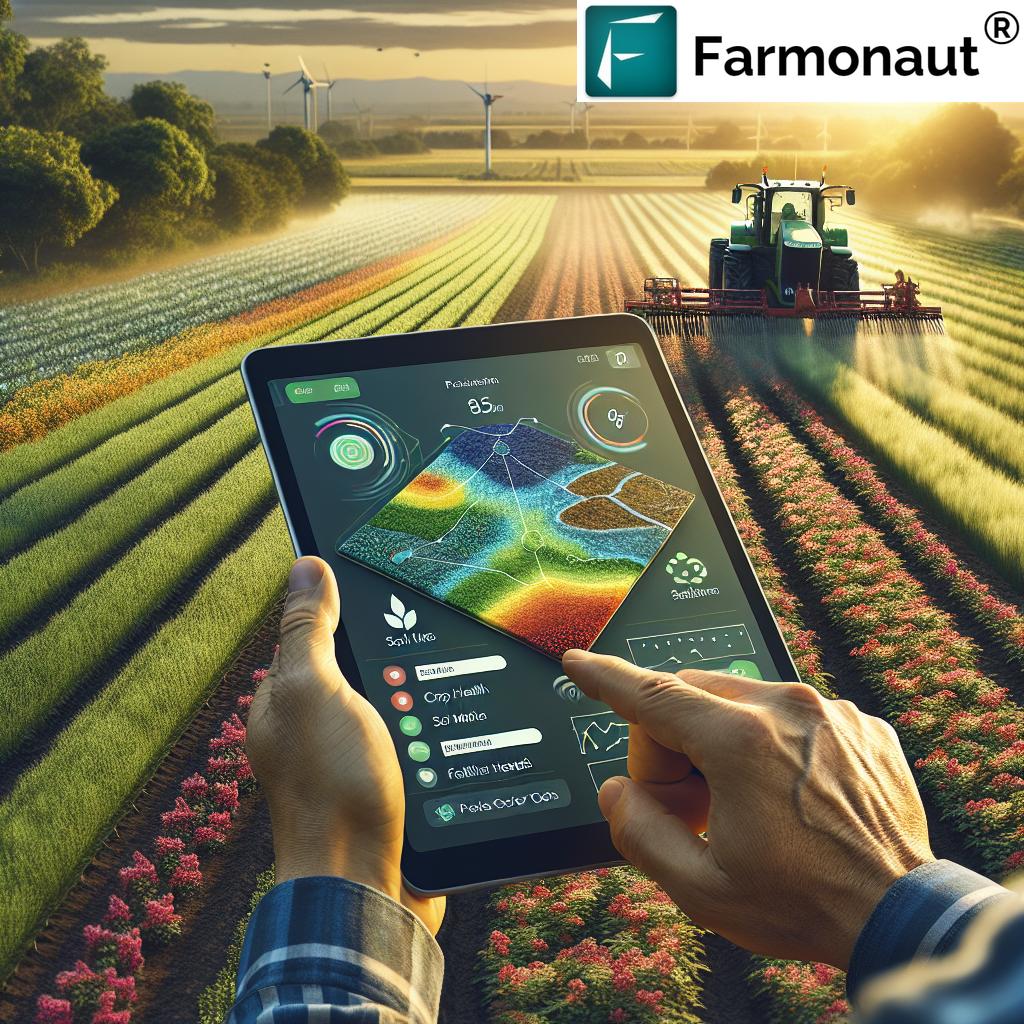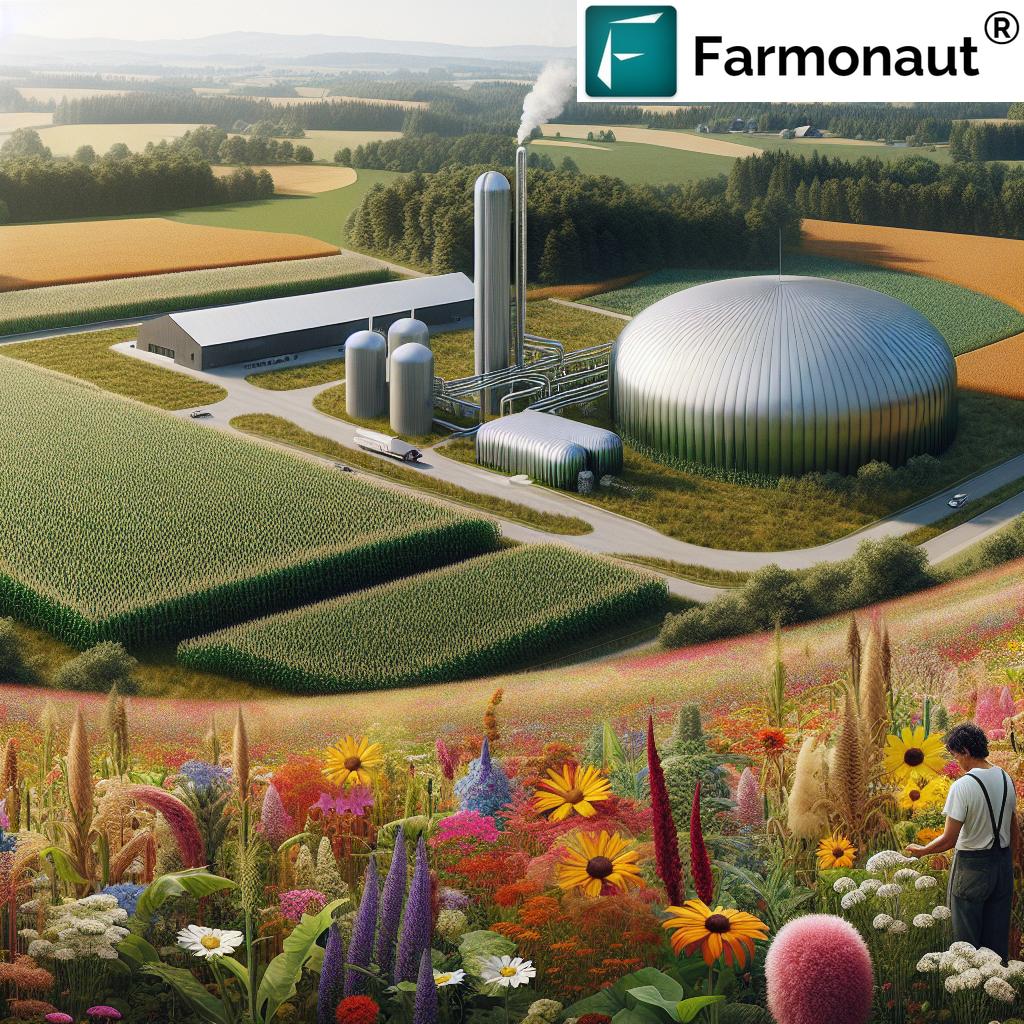Revolutionizing Czech Agriculture: How Satellite Monitoring and Regenerative Farming Boost Soil Health and Carbon Capture

“Satellite monitoring can help measure soil carbon sequestration, potentially enabling farmers to earn carbon credits.“
In the heart of Central Europe, the Czech Republic is witnessing a remarkable transformation in its agricultural landscape. As we delve into the world of regenerative farming practices and satellite monitoring for agriculture, we uncover how these innovative approaches are revolutionizing sustainable agriculture technology. Our journey through the Czech fields reveals a powerful synergy between modern farming techniques and cutting-edge technology, all aimed at combating environmental challenges while boosting crop productivity.
At the forefront of this agricultural revolution is Farmonaut, a pioneering agricultural technology company that’s making waves with its advanced satellite-based farm management solutions. By integrating innovative technology and data-driven insights into traditional farming practices, Farmonaut is paving the way for a more sustainable and productive future in agriculture.
The Power of Regenerative Farming
Regenerative farming is more than just a buzzword; it’s a comprehensive approach to agriculture that focuses on rejuvenating soil health, enhancing biodiversity, and improving the overall ecosystem. In the Czech Republic, farmers are increasingly adopting these practices to not only boost their yields but also to contribute to environmental conservation.
- Soil Carbon Sequestration: One of the key benefits of regenerative farming is its ability to capture and store carbon in the soil. This process, known as soil carbon sequestration, is crucial in the fight against climate change.
- Improved Soil Fertility: By focusing on natural processes and minimizing chemical inputs, regenerative practices enhance soil fertility over time.
- Enhanced Water Infiltration: Healthy soils resulting from regenerative practices have better water retention capabilities, reducing the need for irrigation.
We’ve seen firsthand how Czech farmers implementing these practices are experiencing improved crop resilience and reduced dependency on synthetic fertilizers. The transformation is not just visible in the lush fields but also in the increased biodiversity and healthier ecosystems surrounding these farms.
Satellite Monitoring: The Eye in the Sky
While regenerative farming forms the foundation of this agricultural revolution, satellite monitoring acts as the guiding force, providing invaluable insights and data. Farmonaut’s satellite-based crop health monitoring system is at the cutting edge of this technology, offering Czech farmers a bird’s-eye view of their fields like never before.
Here’s how satellite monitoring is transforming Czech agriculture:
- Real-time Crop Health Assessment: Using multispectral satellite images, farmers can monitor vegetation health through indices like NDVI (Normalized Difference Vegetation Index).
- Soil Moisture Analysis: Satellite data provides insights into soil moisture levels, helping farmers optimize irrigation practices.
- Precision Farming Techniques: With detailed field maps, farmers can implement targeted interventions, reducing waste and improving efficiency.
The integration of satellite monitoring in Czech agriculture is not just enhancing productivity; it’s also playing a crucial role in measuring and verifying the impact of regenerative practices on soil health and carbon capture.
The Synergy of Technology and Nature
The true power of this agricultural revolution lies in the synergy between regenerative farming practices and satellite monitoring. Let’s explore how these two elements work together to create a more sustainable and productive agricultural system in the Czech Republic.
1. Optimizing No-Till Farming
No-till farming is a cornerstone of regenerative agriculture, and satellite monitoring enhances its implementation:
- Soil Disturbance Monitoring: Satellite imagery helps farmers track areas where no-till practices are being effectively implemented.
- Residue Cover Assessment: By analyzing satellite data, farmers can ensure adequate crop residue cover, crucial for soil protection and organic matter buildup.
2. Enhancing Cover Cropping Strategies
Cover cropping is another vital regenerative practice, and satellite technology optimizes its use:
- Growth Tracking: Satellite monitoring allows farmers to track the growth and health of cover crops, ensuring maximum soil coverage and nutrient uptake.
- Termination Timing: By analyzing vegetation indices, farmers can determine the optimal time to terminate cover crops, maximizing their benefits to the soil.
3. Precision Application of Organic Amendments
Organic soil amendments are crucial in regenerative farming, and satellite data ensures their efficient use:
- Variable Rate Application: By creating detailed soil health maps, satellite monitoring enables precise application of compost and manure where they’re needed most.
- Effectiveness Monitoring: Post-application satellite imagery helps farmers assess the impact of organic amendments on soil health and crop growth.
“No-till farming and cover cropping can increase soil organic matter by up to 1% annually, improving water retention and fertility.“
As we continue to explore the Czech agricultural landscape, it’s clear that the combination of regenerative practices and satellite monitoring is not just improving farm productivity; it’s also contributing significantly to environmental conservation efforts. Farmonaut’s technologies are playing a crucial role in this transformation, providing farmers with the tools they need to make informed decisions and optimize their regenerative practices.
Explore Farmonaut’s API for advanced satellite data integration
Measuring Success: Carbon Capture and Soil Health
One of the most exciting aspects of this agricultural revolution in the Czech Republic is the ability to measure and quantify its success. Thanks to advanced satellite monitoring and on-ground sensors, we can now track the improvements in soil health and carbon capture with unprecedented accuracy.
Quantifying Carbon Sequestration
Farmonaut’s advanced satellite monitoring technology is instrumental in measuring soil carbon sequestration:
- Spectral Analysis: Satellite imagery can detect changes in soil organic carbon content through spectral analysis.
- Temporal Tracking: By comparing data over time, farmers can see the gradual increase in soil carbon levels as a result of their regenerative practices.
- Carbon Credit Potential: This precise measurement opens up possibilities for Czech farmers to participate in carbon credit markets, providing an additional income stream while contributing to climate change mitigation.
Assessing Soil Health Improvements
Beyond carbon capture, satellite monitoring provides a comprehensive view of overall soil health:
- Soil Moisture Retention: Satellite data can track improvements in soil moisture retention, a key indicator of soil health.
- Vegetation Health: NDVI and other vegetation indices offer insights into crop health, reflecting the underlying soil conditions.
- Erosion Control: By monitoring bare soil exposure and vegetation cover, satellite imagery helps assess the effectiveness of erosion control measures.
Check out Farmonaut’s API Developer Docs for technical integration details
The Economic Impact: Balancing Productivity and Sustainability
The integration of regenerative farming practices and satellite monitoring is not just an environmental win; it’s also proving to be economically beneficial for Czech farmers. Let’s break down the economic impacts:
1. Reduced Input Costs
- Precision Application: Satellite data enables targeted application of inputs, reducing overall usage and costs.
- Natural Pest Control: Improved soil health leads to stronger plants that are naturally more resistant to pests, reducing the need for pesticides.
2. Increased Yields
- Optimized Growing Conditions: Better soil health and precise management lead to improved crop yields.
- Resilience to Weather Extremes: Healthier soils are more resilient to droughts and floods, ensuring more consistent yields.
3. New Revenue Streams
- Carbon Credits: The potential to earn carbon credits for sequestered carbon opens up new financial opportunities.
- Premium Products: Sustainably grown crops often command higher prices in the market.
Comparative Analysis: Traditional vs. Regenerative Farming
To fully appreciate the impact of regenerative farming practices enhanced by satellite monitoring, let’s compare them with traditional farming methods:
| Farming Practice | Traditional Method | Regenerative Method | Impact on Soil Health (1-10) | Carbon Capture Potential (tons CO2/hectare/year) | Satellite Monitoring Benefits |
|---|---|---|---|---|---|
| Tillage | Intensive tillage | No-till or minimal tillage | 8 | 0.5 – 1.0 | Monitors soil disturbance and residue cover |
| Crop Rotation | Limited rotation | Diverse crop rotation | 7 | 0.3 – 0.5 | Tracks crop diversity and health |
| Fertilizer Use | Synthetic fertilizers | Organic amendments, cover crops | 9 | 0.2 – 0.4 | Optimizes application and monitors effectiveness |
| Pest Management | Chemical pesticides | Integrated Pest Management (IPM) | 6 | 0.1 – 0.2 | Detects early signs of pest infestation |
| Water Management | Flood irrigation | Precision irrigation | 8 | 0.2 – 0.3 | Monitors soil moisture and optimizes water use |
This comparison clearly illustrates the superior performance of regenerative farming practices in terms of soil health and carbon capture. The integration of satellite monitoring enhances these benefits by providing precise, data-driven insights for each practice.
The Role of Farmonaut in Czech Agriculture
Farmonaut’s innovative platform is playing a pivotal role in the transformation of Czech agriculture. By providing advanced satellite-based farm management solutions, Farmonaut is empowering farmers to make data-driven decisions that enhance both productivity and sustainability.
Key Features of Farmonaut’s Platform:
- Real-time Crop Health Monitoring: Using multispectral satellite imagery, Farmonaut provides up-to-date information on crop health, allowing farmers to quickly identify and address issues.
- AI-powered Advisory System: The Jeevn AI system offers personalized recommendations based on satellite data, weather forecasts, and expert knowledge.
- Resource Management Tools: Farmonaut’s platform includes tools for efficient management of agricultural resources, helping farmers optimize their operations.
- Carbon Footprint Tracking: This feature allows agribusinesses to monitor their environmental impact and take steps towards sustainability.
The Future of Czech Agriculture: Sustainable and Tech-Driven
As we look to the future, it’s clear that the combination of regenerative farming practices and satellite monitoring technology is set to reshape Czech agriculture. This innovative approach not only promises to enhance productivity and profitability but also positions the Czech Republic as a leader in sustainable agriculture.
Key Trends to Watch:
- Increased Adoption of Precision Agriculture: More farmers are expected to embrace satellite-based technologies for precise farm management.
- Growth in Carbon Markets: As carbon sequestration becomes more measurable, we anticipate a rise in carbon credit opportunities for farmers.
- Integration of AI and Machine Learning: Advanced algorithms will further enhance the interpretation of satellite data, providing even more accurate and actionable insights.
- Expansion of Regenerative Practices: As benefits become more evident, we expect to see wider adoption of regenerative farming methods across the country.
Conclusion: A Greener, More Productive Future
The revolution in Czech agriculture, driven by the synergy between regenerative farming practices and satellite monitoring, is more than just a technological advancement. It represents a fundamental shift towards a more sustainable, productive, and environmentally responsible approach to farming.
By embracing these innovative methods and technologies, Czech farmers are not only improving their yields and reducing costs but also playing a crucial role in combating climate change and preserving the environment for future generations. The success story unfolding in the Czech Republic serves as an inspiring model for agricultural transformation worldwide.
As we continue to witness the positive impacts of this agricultural revolution, it’s clear that the future of farming lies in the harmonious integration of technology and nature. With companies like Farmonaut leading the way in providing accessible and powerful satellite monitoring tools, we’re optimistic about the potential for widespread adoption of these sustainable practices.
The journey towards a more sustainable and productive agricultural sector is ongoing, but the path forward is clear. By continuing to innovate, adapt, and embrace technologies that work in harmony with nature, Czech agriculture is poised to thrive in the face of global challenges, setting a benchmark for sustainable farming practices worldwide.

Frequently Asked Questions (FAQ)
- What is regenerative farming?
Regenerative farming is an approach to agriculture that focuses on improving soil health, enhancing biodiversity, and capturing carbon from the atmosphere. It involves practices such as no-till farming, cover cropping, and diverse crop rotations. - How does satellite monitoring benefit farmers?
Satellite monitoring provides farmers with real-time data on crop health, soil moisture, and field conditions. This information helps in making informed decisions about irrigation, fertilization, and pest management, leading to optimized resource use and improved yields. - Can regenerative farming really help combat climate change?
Yes, regenerative farming practices can significantly contribute to climate change mitigation by sequestering carbon in the soil. Healthy soils act as carbon sinks, removing CO2 from the atmosphere and storing it in the ground. - How accurate is satellite-based crop monitoring?
Modern satellite monitoring systems, like those used by Farmonaut, can achieve high levels of accuracy. For instance, Farmonaut’s platform provides 90-95% accuracy in organic carbon data, making it a reliable tool for precision agriculture. - Is regenerative farming economically viable for farmers?
While there may be initial costs in transitioning to regenerative practices, many farmers find it economically beneficial in the long run. Reduced input costs, improved soil health leading to better yields, and potential carbon credit earnings contribute to its economic viability.




















